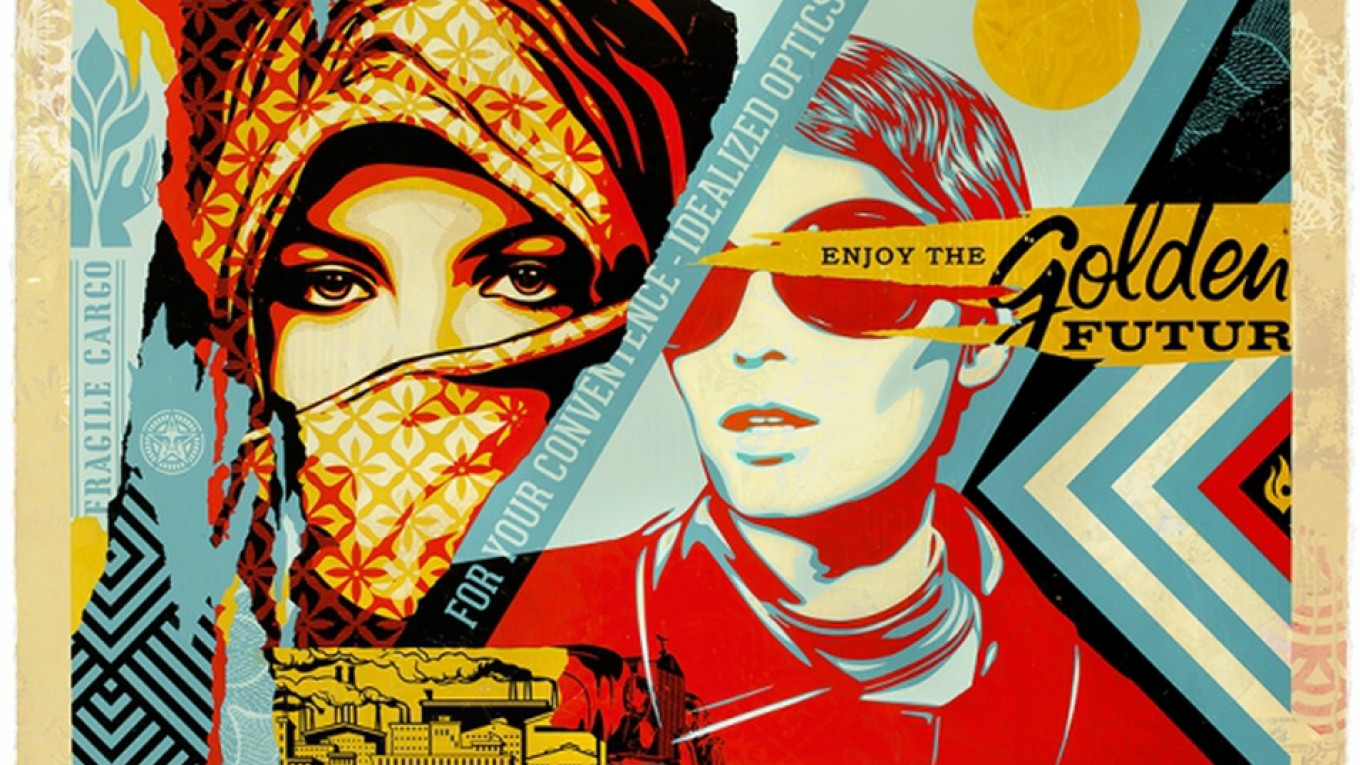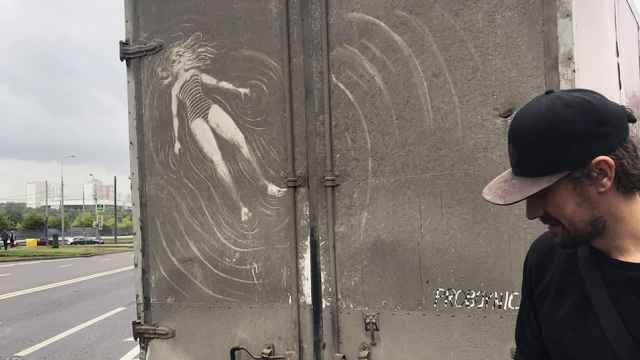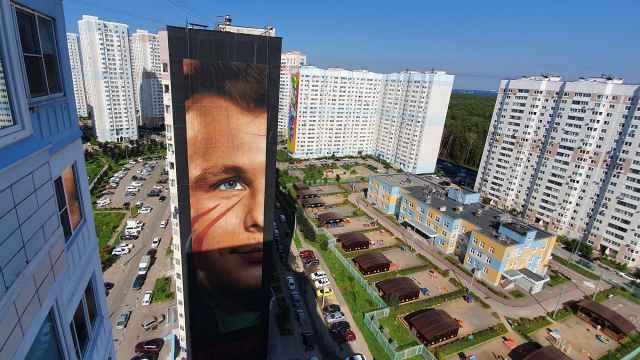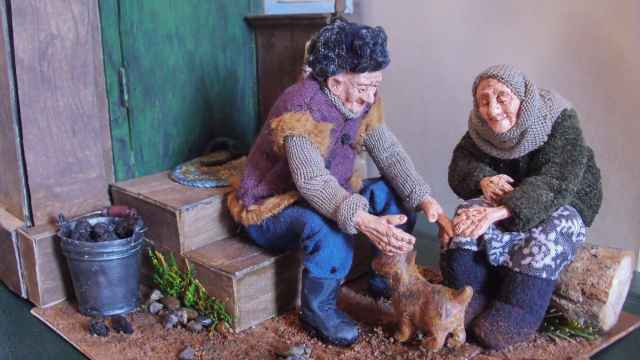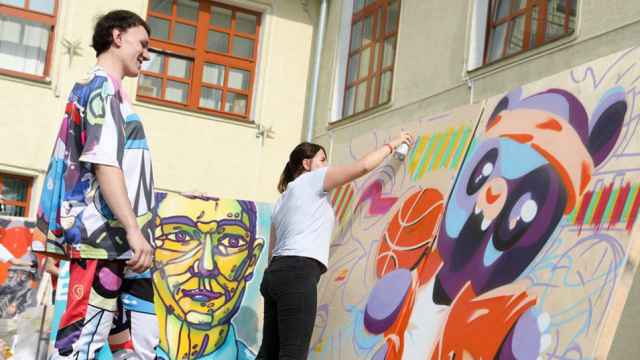On the cusp of WWII and in the face of fascist and communist threats, George Orwell wrote, “We have now sunk to a depth at which the restatement of the obvious is the first duty of intelligent men.”
Although 2018 is not 1939, the American street artist, Shepard Fairey, sees rising inequality, corporate greed, environmental degradation, digital disinformation, and resurgent nationalism as reason enough to indicate what all can see if they take the time to look: the abuse of power in an age of consumerism and complacency.
Fairey’s method for delivering this message in his “Force Majeure” exhibit at MMoMA is as brilliant as it is blunt. In a series of 400 stencil and silkscreen prints that take-up the entire museum, Fairey draws on Russian constructivism, socialist realism, and the masters of Soviet propaganda to illustrate American excess. His rationale for presenting the United States in communist colors is to show that even though the exercise of power in America is often overlooked, it can be just as sinister as it was in the Soviet Union. As Fairey told the Russian press: “Manipulation and control may take subtler forms in the US, but that doesn’t make it less nefarious than the deception that was happening here, and I’ve tried to highlight that by depicting American themes in Soviet-style.”
Fairey’s exhibition begins with a small sketch of the iconic American wrestler, André the Giant. According to Fairey, the sketch emerged when he was trying to teach a friend how to cut a stencil and was forced to use the only magazine he had on-hand. This magazine happened to have a picture of André the Giant on the cover, and Fairey thought the photo was good enough for his pedagogical purpose.
Shortly after producing a basic stencil of the Giant’s face, the sketch took on a life of its own. First, Fairey turned the sketch into a massive poster, inscribed his now familiar “OBEY” at the top, and began hanging copies of the image in his neighborhood. The absurd poster stunned viewers and compelled them to seek its meaning in the broader world.
The success of Fairey’s initial sketch led to further iterations of the André the Giant theme, culminating in a “Worldwide Propaganda” piece in which “OBEY” is penciled into the head of a Soviet hammer ready to be wielded against anyone who dare stray from the Giant’s command.
Two additional prints – “Lifeguard” and “Paradise” – capture the critical spirit of the exhibit. “Lifeguard” consists of three palm trees and a beach in the foreground, an oil pump in the background, and the caption: “Lifeguard: Not on Duty.”“Paradise” shows a young couple relaxing by the sea with electricity towers menacing, and the caption reads: “Enjoy Paradise Until the Tide Turns”. Again, the messages here are about as blunt as they can be, but they reinforce Fairey’s belief that we perilously ignore environmental concerns and our own well-being in the name of corporate profitability. In Fairey’s words: “We are addicted to oil, but for what? For money? It’s killing us!”
Finally, a review of Fairey’s work would be incomplete without mentioning his most famous piece, “Hope: Obama 2008.” The poster depicts Obama looking confidently into the future with “HOPE” inscribed at the bottom in the same way that “OBEY” was placed atop Fairey’s first poster of André the Giant.
There was of course something ironic about producing a portrait of Obama in fine Soviet-style back in 2008, and at the opening of his exhibition in Moscow, Fairey said, “Like the early-Soviet aspirations, Obama’s liberal promises led to disappointment.”
But regardless of Fairey’s political views, the image remains as a symbol of the artist, his subject, and a particular time in American politics and art.
See Shepard Fairey’s show at MMoMA until Monday.
10 Gogelevsky Bulvar. Metro Kropotkinskaya. www.mmoma.ru
A Message from The Moscow Times:
Dear readers,
We are facing unprecedented challenges. Russia's Prosecutor General's Office has designated The Moscow Times as an "undesirable" organization, criminalizing our work and putting our staff at risk of prosecution. This follows our earlier unjust labeling as a "foreign agent."
These actions are direct attempts to silence independent journalism in Russia. The authorities claim our work "discredits the decisions of the Russian leadership." We see things differently: we strive to provide accurate, unbiased reporting on Russia.
We, the journalists of The Moscow Times, refuse to be silenced. But to continue our work, we need your help.
Your support, no matter how small, makes a world of difference. If you can, please support us monthly starting from just $2. It's quick to set up, and every contribution makes a significant impact.
By supporting The Moscow Times, you're defending open, independent journalism in the face of repression. Thank you for standing with us.
Remind me later.


